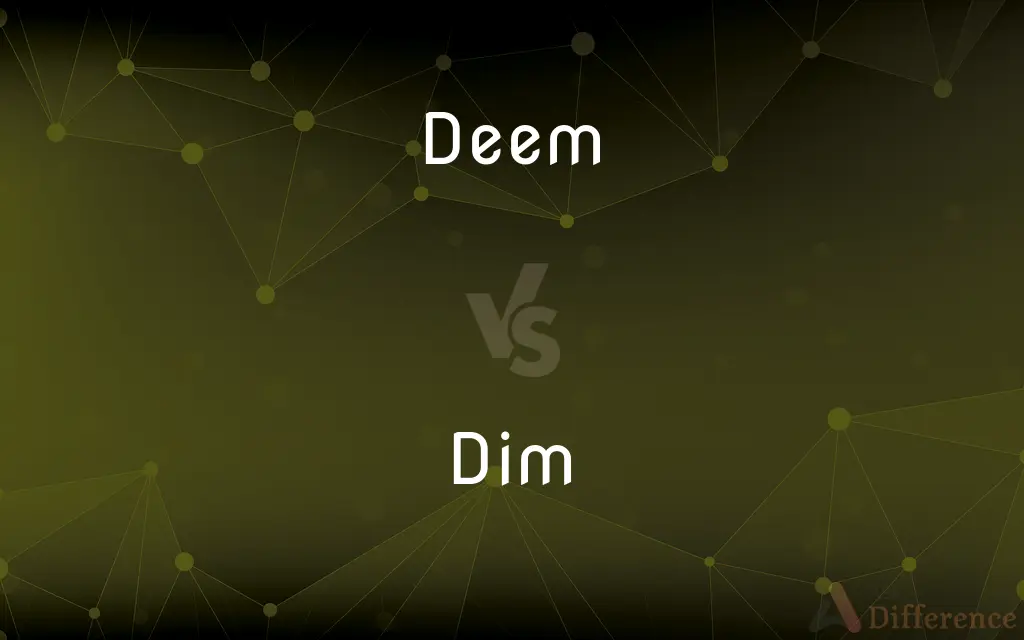Deem vs. Dim — What's the Difference?
By Tayyaba Rehman & Urooj Arif — Updated on February 27, 2024
Deem means to consider or judge something in a certain way, involving a subjective judgment. Dim refers to reduced brightness or clarity, describing a physical characteristic or perception.

Difference Between Deem and Dim
Table of Contents
ADVERTISEMENT
Key Differences
Deem involves a mental process of judgment or evaluation, where an individual forms an opinion or decision about something based on their assessment. Dim, in contrast, primarily describes a lack of light or clarity, whether it's visual perception, such as a dimly lit room, or metaphorically, as in a dim understanding of a concept.
For instance, one might deem an action necessary after evaluating the circumstances. The term dim does not involve judgment but rather states an observable or perceived condition.
The use of "deem" is subjective and varies based on personal beliefs, experiences, or information, indicating a cognitive process. When someone deems something to be true, they are applying their own criteria or standards to make a judgment. "Dim" is used to describe objective states or conditions that can be observed or felt by others, not reliant on personal judgment but on sensory perception. A dim light is a physical reality that can be measured or noticed, unlike the subjective decision-making implied by "deem."
Despite their differences, both terms can be used metaphorically to describe mental or intellectual states. One might deem a solution appropriate based on a dim understanding of the problem, showing how subjective judgment can be influenced by limited perception or clarity.
Comparison Chart
Definition
To consider or judge something in a certain way.
Having reduced brightness or clarity.
ADVERTISEMENT
Nature
Subjective judgment or evaluation.
Objective state or condition related to light or clarity.
Usage Context
Decision-making, opinions, beliefs.
Descriptions of light, visibility, understanding.
Example Usage
"She deemed it necessary to leave early."
"The room was too dim for reading."
Metaphorical Use
Can imply a judgment based on assessment.
Often used to describe lack of clarity in understanding.
Compare with Definitions
Deem
To make a judgment or decision based on criteria.
She deemed him fit for the position.
Dim
Low in intensity or enthusiasm.
The applause was dim and short-lived.
Deem
To regard or think of in a particular manner.
They deemed the meeting unnecessary.
Dim
Faint or vague.
She had a dim memory of their first meeting.
Deem
To come to think or judge.
I deem it wise to wait for more information.
Dim
Lacking in brightness.
The dim lighting made it hard to read.
Deem
To judge or consider in a specific way.
The jury deemed the evidence sufficient for a conviction.
Dim
To make less bright.
The app dims the screen to save battery.
Deem
To hold as an opinion.
He deemed the task impossible given the current resources.
Dim
Not clear or seen clearly.
His future prospects seemed dim.
Deem
(ambitransitive) To think, judge, or have or hold as an opinion; to decide or believe on consideration; to suppose.
Dim
Lacking in brightness
A dim room.
Deem
An opinion, a judgment, a surmise.
Dim
Emitting only a small amount of light; faint
A dim light bulb.
Deem
To be of opinion; to think; to estimate; to opine; to suppose.
And deemest thou as those who pore,With aged eyes, short way before?
Dim
Lacking luster; dull or subdued
Dim, faded colors.
Deem
To pass judgment.
Dim
Not bright or colorful.
The lighting was too dim for me to make out his facial features.
Deem
Opinion; judgment.
Dim
To render dim, obscure, or dark; to make less bright or distinct
Dim
Become dim or lusterless;
The lights dimmed and the curtain rose
Dim
Lacking in light; not bright or harsh;
A dim light beside the bed
Subdued lights and soft music
Dim
Made dim or less bright;
The dimmed houselights brought a hush of anticipation
Dimmed headlights
We like dimmed lights when we have dinner
Common Curiosities
What does it mean to deem something?
To deem something means to judge or consider it in a specific way based on one's assessment or opinion.
Can dim be used metaphorically?
Yes, dim can be used metaphorically to describe situations, prospects, or understandings that are perceived as unclear or bleak.
How do deem and dim differ in a legal context?
In a legal context, deem might be used to describe a determination made by a judge or law, while dim would not typically apply unless describing the clarity of evidence or similar.
Are there synonyms for deem and dim that can clarify their meanings?
For deem, synonyms include consider, judge, or believe. For dim, synonyms include faint, unclear, or dull.
How does the context affect the use of deem and dim?
The context affects their use significantly; deem is used in contexts requiring judgment or opinion, while dim is used to describe physical characteristics or perceptions.
How can understanding the difference between deem and dim enhance communication?
Understanding the difference can enhance communication by ensuring that expressions of judgment and descriptions of physical states or perceptions are clearly and accurately conveyed.
What role do deem and dim play in literature?
In literature, both terms can add depth to narrative and character analysis, with deem enhancing psychological depth and dim enriching sensory description.
What does dim mean?
Dim refers to something that has reduced brightness or clarity, or is lacking in light.
Can deem and dim be used interchangeably?
No, deem and dim cannot be used interchangeably as they pertain to different contexts: subjective judgment versus a state of light or clarity.
Can the misuse of deem and dim lead to misunderstandings?
Yes, misuse can lead to confusion, especially if deem is incorrectly used in place of dim or vice versa, altering the intended meaning.
How does cultural context influence the understanding of deem and dim?
Cultural context may influence the interpretation of these words, especially in metaphorical uses, where cultural nuances can affect the perception of judgment or clarity.
Is deem always subjective?
Yes, deem is inherently subjective, as it relies on an individual's judgment or opinion.
Can something be deemed dim?
Yes, something can be deemed dim if an individual judges it to be lacking in brightness or clarity, though this combines both subjective judgment and objective observation.
Is it possible for the meaning of deem and dim to overlap?
While their primary meanings do not overlap, metaphorical uses can sometimes blur the distinction, especially when discussing mental or perceptual clarity.
How do deem and dim contribute to language diversity?
They enrich language by offering nuanced ways to express judgment and describe sensory experiences, contributing to precise and varied communication.
Share Your Discovery

Previous Comparison
Rappel vs. Repel
Next Comparison
Foundry vs. ForgeAuthor Spotlight
Written by
Tayyaba RehmanTayyaba Rehman is a distinguished writer, currently serving as a primary contributor to askdifference.com. As a researcher in semantics and etymology, Tayyaba's passion for the complexity of languages and their distinctions has found a perfect home on the platform. Tayyaba delves into the intricacies of language, distinguishing between commonly confused words and phrases, thereby providing clarity for readers worldwide.
Co-written by
Urooj ArifUrooj is a skilled content writer at Ask Difference, known for her exceptional ability to simplify complex topics into engaging and informative content. With a passion for research and a flair for clear, concise writing, she consistently delivers articles that resonate with our diverse audience.














































